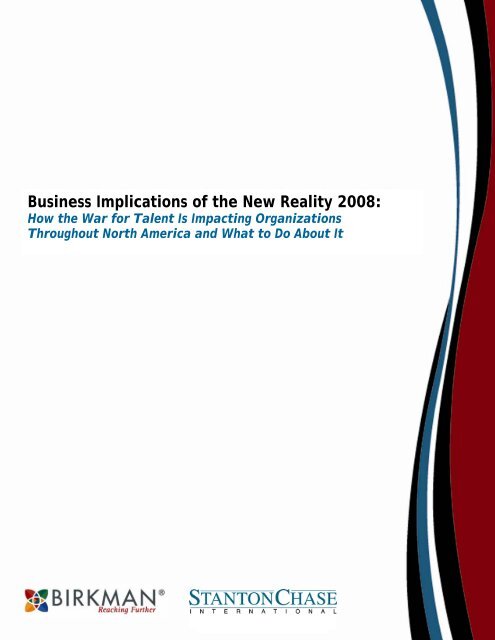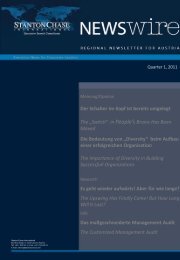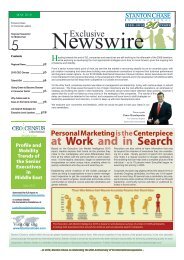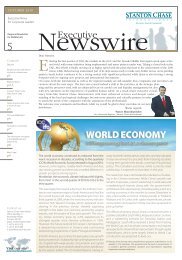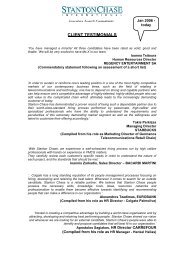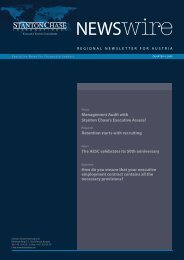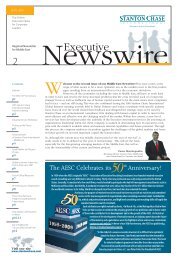Business Implications of the New Reality 2008: - Stanton Chase ...
Business Implications of the New Reality 2008: - Stanton Chase ...
Business Implications of the New Reality 2008: - Stanton Chase ...
You also want an ePaper? Increase the reach of your titles
YUMPU automatically turns print PDFs into web optimized ePapers that Google loves.
1<br />
The <strong>New</strong> <strong>Reality</strong> <strong>2008</strong><br />
<strong>Business</strong> <strong>Implications</strong> <strong>of</strong> <strong>the</strong> <strong>New</strong> <strong>Reality</strong> <strong>2008</strong>:<br />
How <strong>the</strong> War for Talent Is Impacting Organizations<br />
Throughout North America and What to Do About It
2<br />
Executive Summary<br />
The <strong>New</strong> <strong>Reality</strong> <strong>2008</strong><br />
The War for Talent has been discussed, examined, quantified, documented and accepted<br />
since shortly after McKinsey & Co. coined <strong>the</strong> phrase almost ten years ago. 1 Now, several<br />
forces have brought <strong>the</strong> intensity and urgency <strong>of</strong> McKinsey & Co.’s predictions and<br />
forecasts to <strong>the</strong> forefront as <strong>the</strong> most pressing talent management challenge <strong>of</strong> <strong>2008</strong>. The<br />
War for Talent is <strong>the</strong> <strong>the</strong>oretical forecast; <strong>the</strong> <strong>New</strong> <strong>Reality</strong> is <strong>the</strong> all-too-accurate<br />
condition currently faced by business leaders. The <strong>New</strong> <strong>Reality</strong> is simply <strong>the</strong> fact that for<br />
an organization to survive (and thrive), it must face <strong>the</strong>se challenges head-on. The <strong>New</strong><br />
<strong>Reality</strong> is that The War for Talent is not some far-<strong>of</strong>f suggestion for what <strong>the</strong> future might<br />
hold—The War for Talent is real, and it is here.<br />
Economic trends and generational issues are <strong>the</strong> leading causes, but <strong>the</strong> confluence <strong>of</strong><br />
<strong>the</strong>se challenges is what has accelerated this talent shortage into <strong>the</strong> <strong>New</strong> <strong>Reality</strong> now<br />
facing North American organizations. In fact, many economic trends and generational<br />
issues now overlap and affect one ano<strong>the</strong>r, increasing <strong>the</strong> impact <strong>of</strong> <strong>the</strong>se forces. It is<br />
obvious that highly talented employees are going to be in short supply sooner ra<strong>the</strong>r than<br />
later. 2<br />
In response to this, executives and managers across <strong>the</strong> United States and Canada were<br />
queried to determine <strong>the</strong>ir thoughts and perceptions in regard to generational gaps, talent<br />
shortages and, most importantly, <strong>the</strong> <strong>New</strong> <strong>Reality</strong>. This report focuses on how companies<br />
are preparing to fight The War for Talent that is already upon <strong>the</strong>m and how <strong>the</strong>y are<br />
coping with this <strong>New</strong> <strong>Reality</strong>. It also examines <strong>the</strong> concerns <strong>the</strong>y have, <strong>the</strong> effects <strong>the</strong>y<br />
have already experienced and <strong>the</strong>ir expectations for <strong>the</strong> future. Most importantly, this<br />
report <strong>of</strong>fers an outline <strong>of</strong> strategies and tactics to thrive and win.<br />
Key findings examined in this report include:<br />
• Talent acquisition planning is sorely lacking—just 18 percent <strong>of</strong> respondents report<br />
having a plan implemented.<br />
• The <strong>New</strong> <strong>Reality</strong> affects all levels within organizations.<br />
• Identifying and developing leaders within organizations is as important as<br />
attracting new, top-flight talent.<br />
• Retention is a major challenge for 71 percent <strong>of</strong> respondents and <strong>the</strong>ir<br />
organizations.<br />
• Levels <strong>of</strong> awareness and concern are greater in Canada than in <strong>the</strong> U.S. Likewise,<br />
Canadian organizations report being more prepared for <strong>the</strong> <strong>New</strong> <strong>Reality</strong> than do<br />
those in <strong>the</strong> U.S.<br />
These findings are based on <strong>the</strong> “Talent Shortage Survey” conducted by Equation Research<br />
on behalf <strong>of</strong> <strong>Stanton</strong> <strong>Chase</strong> International and Birkman, International in Q3, 2007.<br />
1<br />
Fishman, Charles. “The War for Talent.” Fast Company, July 1998.<br />
2<br />
Bersin, Josh. “The War for Talent.” Elearning, Winter 2007.<br />
http://www.elearning.b2bmediaco.com/issues/winter07/winter07_featuredstory_2.html
3<br />
Table <strong>of</strong> Contents<br />
The <strong>New</strong> <strong>Reality</strong> <strong>2008</strong><br />
Methodology ......................................................................................... 4<br />
Demographics........................................................................................ 4<br />
The <strong>New</strong> <strong>Reality</strong>..................................................................................... 6<br />
Perceptions <strong>of</strong> <strong>the</strong> <strong>New</strong> <strong>Reality</strong>................................................................ 6<br />
Preparations for <strong>the</strong> <strong>New</strong> <strong>Reality</strong> ............................................................. 9<br />
Leadership Development ......................................................................... 12<br />
Value Proposition ............................................................................... 12<br />
Identifying and Developing Leaders.......................................................... 12<br />
The Role <strong>of</strong> Emotional Intelligence ....................................................... 16<br />
Retaining in <strong>the</strong> <strong>New</strong> <strong>Reality</strong>..................................................................... 17<br />
Thriving in <strong>the</strong> <strong>New</strong> <strong>Reality</strong> and Winning The War for Talent .............................. 18<br />
How to Win.................................................................................... 19
4<br />
Methodology<br />
The <strong>New</strong> <strong>Reality</strong> <strong>2008</strong><br />
Because <strong>of</strong> <strong>the</strong> large number <strong>of</strong> respondents that participated in this survey, we are 99<br />
percent confident that <strong>the</strong> responses <strong>of</strong> <strong>the</strong> population to <strong>the</strong> survey questions would<br />
be within a 5 percent margin <strong>of</strong> error from <strong>the</strong> figures stated herein.<br />
The survey was sent via email to nearly 37,000 executives and managers. The survey<br />
was live for 30 days, and a response level high enough to drive <strong>the</strong> statistical<br />
confidence stated above were recorded and drive <strong>the</strong> results and conclusions <strong>of</strong> this<br />
report. Each respondent answered <strong>the</strong> questionnaire via an online survey tool and was<br />
assured <strong>of</strong> his or her confidentiality. Their responses will be used only in this<br />
aggregate analysis.<br />
Demographics<br />
A statistically relevant number <strong>of</strong> Canadian and U.S. organizations make up <strong>the</strong><br />
respondent populations. Almost half <strong>of</strong> all respondents (49 percent) work for<br />
companies with less than 1,000 employees, and 16 percent each are from<br />
organizations with 1,001-2,999 employees and 20,000 or more employees.<br />
Size <strong>of</strong> enterprise by number <strong>of</strong> employees<br />
The broad, representative sample <strong>of</strong> company<br />
sizes supports <strong>the</strong> data and <strong>the</strong> validity <strong>of</strong> our<br />
findings.<br />
7%<br />
16%<br />
6%<br />
6%<br />
16%<br />
49%
5<br />
The <strong>New</strong> <strong>Reality</strong> <strong>2008</strong><br />
All respondents are involved in formulating or implementing <strong>the</strong>ir companies’<br />
recruiting, hiring and retention strategies. The largest faction <strong>of</strong> respondents is very<br />
involved (65 percent) and 35 percent are somewhat involved.<br />
The largest faction <strong>of</strong> respondents represents companies with less than $50 million in<br />
revenue in 2006 (34 percent), followed by companies with $1-5 billion in 2006 revenue<br />
(16 percent).<br />
Size <strong>of</strong> enterprise by annual revenue<br />
The broad, representative sample <strong>of</strong> company<br />
sizes supports <strong>the</strong> data and <strong>the</strong> validity <strong>of</strong> our<br />
findings.<br />
8%<br />
7%<br />
6%<br />
16% 7%<br />
9%<br />
9%<br />
4%<br />
Eighteen percent <strong>of</strong> respondents hold president, CEO, owner or partner roles in <strong>the</strong>ir<br />
organizations, and 14 percent serve as vice president <strong>of</strong> human resources. Most <strong>of</strong> <strong>the</strong><br />
respondents who chose “o<strong>the</strong>r,” specified <strong>the</strong>ir roles within <strong>the</strong> director or manager<br />
categories, including senior director, senior manager and project manager, or as a<br />
senior role within a discipline o<strong>the</strong>r than human resources such as operations, finance,<br />
sales and business intelligence.<br />
34%
6<br />
The <strong>New</strong> <strong>Reality</strong><br />
The <strong>New</strong> <strong>Reality</strong> <strong>2008</strong><br />
Economic trends and strong economic growth have led to this <strong>New</strong> <strong>Reality</strong><br />
characterized by shorter job tenures, changing generational values, a surplus <strong>of</strong> vacant<br />
positions and scarce talent. With large numbers <strong>of</strong> baby boomers retiring around <strong>the</strong><br />
same time and this trend accelerating rapidly in 2010, smaller, younger generations<br />
are unable to fill <strong>the</strong> amount <strong>of</strong> jobs left vacant. In addition, <strong>the</strong>re is a shortage <strong>of</strong><br />
skills and experience among younger generations, and for <strong>the</strong> first time ever, four<br />
generations comprise <strong>the</strong> workforce. With <strong>the</strong>se different generations come varying<br />
values, work ethics, perceptions and priorities that, especially when combined with<br />
macroeconomic trends, produce startling changes in <strong>the</strong> workplace.<br />
Take, for example, <strong>the</strong> fact that <strong>the</strong> average tenure for baby boomer employees was<br />
15 years in 1980 and 10 years in 2000. The average tenure for Generation X in 2000<br />
was just five years. According to <strong>the</strong> U.S. Bureau <strong>of</strong> Labor Statistics, <strong>the</strong> average job<br />
tenure for employees today is just four years.<br />
These changes in job tenure can be attributed to both economic changes and<br />
differences among generations. Generation X and younger generations demand more<br />
from <strong>the</strong>ir employers. They require a reason to stay with <strong>the</strong>ir current employers<br />
(ra<strong>the</strong>r than leave), and <strong>the</strong>y demand a work-life balance that allows <strong>the</strong>m to pursue<br />
both pr<strong>of</strong>essional and personal endeavors. Add to <strong>the</strong>se statistics <strong>the</strong> prediction that<br />
<strong>the</strong>re will be 11.5 million more jobs than workers by 2010, and it is obvious that<br />
organizations must face this <strong>New</strong> <strong>Reality</strong> now.<br />
Perceptions <strong>of</strong> <strong>the</strong> <strong>New</strong> <strong>Reality</strong><br />
Almost 40 percent <strong>of</strong> business unit leaders, 52 percent <strong>of</strong> executives and 62 percent <strong>of</strong><br />
CEOs understand <strong>the</strong> implications <strong>of</strong> <strong>the</strong> <strong>New</strong> <strong>Reality</strong>. More than half <strong>of</strong> respondents<br />
(54 percent) believe <strong>the</strong>re is a current shortage <strong>of</strong> quality leadership talent in <strong>the</strong><br />
workforce, while 40 percent believe <strong>the</strong>re will be a shortage in <strong>the</strong> near future. Just 6<br />
percent said <strong>the</strong>re is not a shortage in <strong>the</strong> foreseeable future. Fur<strong>the</strong>r, 90 percent <strong>of</strong><br />
respondents believe that when it comes to qualified leadership talent, <strong>the</strong>re is a<br />
perceptible gap between baby boomers and younger generations. Of those, 34 percent<br />
believe <strong>the</strong> gap is significant, and 46 percent believe it is moderate.
7<br />
The <strong>New</strong> <strong>Reality</strong> <strong>2008</strong><br />
How well does each <strong>of</strong> <strong>the</strong> following leadership areas <strong>of</strong> your organization<br />
understand <strong>the</strong> business implications <strong>of</strong> <strong>the</strong> talent shortage?<br />
Human resources have been tuned in to <strong>the</strong> talent shortage problem for many<br />
years now, and CEOs and executive committees are also very aware because<br />
<strong>the</strong> current health and future growth <strong>of</strong> <strong>the</strong> organization rests with <strong>the</strong>m.<br />
<strong>Business</strong> unit leaders, however, are more tactical and not necessarily focused<br />
on <strong>the</strong> “big picture.”
8<br />
Number <strong>of</strong> respondents who understand <strong>the</strong> shortage<br />
The <strong>New</strong> <strong>Reality</strong> <strong>2008</strong><br />
94.1 percent <strong>of</strong><br />
respondents<br />
acknowledge<br />
<strong>the</strong>re is or will<br />
soon be a talent<br />
shortage.<br />
Do you believe <strong>the</strong>re is a “gap” between baby boomers and<br />
younger generations when it comes to qualified leadership talent?<br />
90.4 percent <strong>of</strong> respondents<br />
believe <strong>the</strong>re is a talent gap.
9<br />
The <strong>New</strong> <strong>Reality</strong> <strong>2008</strong><br />
Respondents indicated that <strong>the</strong> current<br />
shortage <strong>of</strong> talent affects all levels <strong>of</strong> <strong>the</strong>ir<br />
organizations. Almost half <strong>of</strong> all<br />
respondents (48 percent) said that <strong>the</strong><br />
current shortage <strong>of</strong> talent critically or<br />
significantly affects <strong>the</strong> senior management level in <strong>the</strong>ir organizations. Forty-five<br />
percent each reported <strong>the</strong> same effects on <strong>the</strong> executive level and in middle<br />
management. Overall, 37 percent reported critical or significant effects on <strong>the</strong><br />
pr<strong>of</strong>essional level (legal, accounting, medical, etc.) in <strong>the</strong>ir organizations.<br />
Respondents from <strong>the</strong> U.S. reported <strong>the</strong>se effects more so than did Canadian<br />
respondents: 39 percent <strong>of</strong> U.S. respondents reported critical or significant effects on<br />
<strong>the</strong> pr<strong>of</strong>essional level, compared to just 28 percent <strong>of</strong> respondents in Canada.<br />
The largest faction <strong>of</strong> respondents<br />
reported that <strong>the</strong>ir organizations are<br />
moderately concerned about The War for<br />
Talent and this <strong>New</strong> <strong>Reality</strong> (35 percent),<br />
and 32 percent said <strong>the</strong>ir organizations are significantly concerned. Respondents from<br />
<strong>the</strong> U.S. are less concerned about <strong>the</strong> <strong>New</strong> <strong>Reality</strong> than are <strong>the</strong>ir Canadian<br />
counterparts, with a quarter <strong>of</strong> respondents from U.S. companies reporting that <strong>the</strong>ir<br />
organizations are somewhat or not at all concerned, compared to just 16 percent <strong>of</strong><br />
respondents in Canada. Likewise, 47 percent <strong>of</strong> Canadian respondents reported that<br />
<strong>the</strong>ir companies are significantly or extremely concerned with <strong>the</strong> <strong>New</strong> <strong>Reality</strong>, while<br />
just 41 percent <strong>of</strong> U.S. respondents did <strong>the</strong> same.<br />
Preparations for <strong>the</strong> <strong>New</strong> <strong>Reality</strong><br />
Almost half <strong>of</strong> respondents (49 percent) indicated that <strong>the</strong>ir organizations are<br />
moderately prepared for <strong>the</strong> <strong>New</strong> <strong>Reality</strong>, meaning that <strong>the</strong>y are currently in <strong>the</strong><br />
process <strong>of</strong> planning and implementing a plan to address <strong>the</strong> talent shortage. Just more<br />
than a third <strong>of</strong> respondents (36 percent) reported that little or nothing is being done<br />
within <strong>the</strong>ir organizations. Just 1 percent said that <strong>the</strong>ir companies are totally<br />
prepared for <strong>the</strong> <strong>New</strong> <strong>Reality</strong>. While <strong>the</strong>se numbers are not reassuring, <strong>the</strong>y do<br />
indicate hope for successfully managing <strong>the</strong> <strong>New</strong> <strong>Reality</strong>: at <strong>the</strong> very least, <strong>the</strong>se<br />
companies recognize <strong>the</strong> <strong>New</strong> <strong>Reality</strong> and realize <strong>the</strong>y must take action.
10<br />
The <strong>New</strong> <strong>Reality</strong> <strong>2008</strong><br />
What is your organization’s readiness for <strong>the</strong> <strong>New</strong> <strong>Reality</strong>?<br />
The bell curve shows that<br />
while organizations are<br />
not fully prepared for <strong>the</strong><br />
<strong>New</strong> <strong>Reality</strong>, <strong>the</strong>y are<br />
aware <strong>of</strong> it and taking<br />
steps to ready <strong>the</strong>mselves<br />
for its effects.<br />
Respondents from <strong>the</strong> U.S. reported that <strong>the</strong>ir organizations are less prepared for <strong>the</strong><br />
<strong>New</strong> <strong>Reality</strong> than did <strong>the</strong>ir Canadian counterparts. Thirty-seven percent <strong>of</strong> respondents<br />
from U.S. companies reported being somewhat or not at all prepared, compared to<br />
just 29 percent <strong>of</strong> Canadian respondents.<br />
Overall, 41 percent believe <strong>the</strong> leadership <strong>of</strong> <strong>the</strong>ir organizations somewhat understand<br />
what needs to be done to attract, assess and retain <strong>the</strong> new generation <strong>of</strong> employees.<br />
About a quarter indicated that <strong>the</strong>ir leadership understands a significant amount, and<br />
ano<strong>the</strong>r quarter reported that <strong>the</strong>ir leadership understands a little (24 and 26 percent,<br />
respectively). Just 4 percent believe <strong>the</strong>ir leadership understands completely, and 5<br />
percent said <strong>the</strong>ir leadership does not understand at all.
11<br />
The <strong>New</strong> <strong>Reality</strong> <strong>2008</strong><br />
How well does <strong>the</strong> leadership <strong>of</strong> your organization understand<br />
what needs to be done to attract, assess and retain <strong>the</strong><br />
new generations <strong>of</strong> employees?<br />
Again, <strong>the</strong> bell curve<br />
demonstrates that <strong>the</strong>re is<br />
hope for attracting,<br />
assessing and retaining <strong>the</strong><br />
new generations <strong>of</strong><br />
employees in this <strong>New</strong><br />
<strong>Reality</strong>.<br />
Respondents from Canada reported that <strong>the</strong>ir leadership understands what needs to be<br />
done to attract, assess and retain <strong>the</strong> new generations <strong>of</strong> employees more so than did<br />
<strong>the</strong>ir counterparts in <strong>the</strong> U.S. Just a quarter <strong>of</strong> Canadian respondents reported that<br />
<strong>the</strong> leadership in <strong>the</strong>ir organizations understands a little or not at all, compared to<br />
almost a third <strong>of</strong> U.S. respondents (32 percent). Again, <strong>the</strong> bell curve shown in <strong>the</strong><br />
graph above demonstrates that <strong>the</strong>re is hope for attracting, assessing and retaining<br />
<strong>the</strong> new generations <strong>of</strong> employees in this <strong>New</strong> <strong>Reality</strong>.<br />
More than half <strong>of</strong> all respondents (55 percent) reported that <strong>the</strong> CEOs <strong>of</strong> <strong>the</strong>ir<br />
organizations are very or completely willing to embrace <strong>the</strong> strategies necessary to<br />
compete.<br />
However, respondents in Canada indicated that <strong>the</strong>ir CEOs are willing to do this more<br />
so than did U.S. respondents. Sixty-one percent <strong>of</strong> Canadian respondents said <strong>the</strong>ir<br />
CEOs are very or completely willing to embrace <strong>the</strong>se necessary initiatives, compared<br />
to just 53 percent <strong>of</strong> respondents in <strong>the</strong> U.S. Likewise, 18 percent <strong>of</strong> U.S. respondents<br />
reported that <strong>the</strong>ir CEOs are a little or not at all willing to do so, compared to just 10<br />
percent <strong>of</strong> <strong>the</strong>ir Canadian counterparts.
12<br />
Leadership Development<br />
Value Proposition<br />
The <strong>New</strong> <strong>Reality</strong> <strong>2008</strong><br />
Overall, 46 percent <strong>of</strong> respondents’ organizations do not have an employment value<br />
proposition that differentiates <strong>the</strong>m from competitors. While respondents from <strong>the</strong><br />
U.S. and Canada had similar responses, <strong>the</strong> largest discrepancies reported were among<br />
companies with different revenues in 2006. Just 50 percent <strong>of</strong> respondents from<br />
companies with less than $50 million in 2006 revenue reported having an employment<br />
value proposition, compared to 58 percent <strong>of</strong> respondents from companies with more<br />
than $1 billion in revenue in 2006.<br />
Identifying and Developing Leaders<br />
Developing talent that is already resident within <strong>the</strong> organization <strong>of</strong>fers <strong>the</strong> greatest<br />
long-term advantage in winning <strong>the</strong> War for Talent. 3 Overall, 57 percent <strong>of</strong><br />
respondents reported that <strong>the</strong>ir organizations measure personality characteristics<br />
when identifying leaders.<br />
Identifying leaders is fundamental to both <strong>the</strong> recruitment and retention <strong>of</strong> valuable<br />
human capital, yet 43 percent <strong>of</strong> organizations do not avail <strong>the</strong>mselves <strong>of</strong> validated<br />
scientific personality assessment instruments. Why? Perhaps it is a prejudice against<br />
valuing s<strong>of</strong>ter, yet powerful leadership skills like emotional intelligence and placing<br />
too much emphasis on hard skills.<br />
Respondents indicated that <strong>the</strong> three most important personality characteristics to<br />
measure when identifying future leaders are <strong>the</strong> ability to be strategic and futureoriented<br />
(66 percent), <strong>the</strong> ability to inspire and be emotionally positive (43 percent)<br />
and <strong>the</strong> ability to be resourceful and adaptable (34 percent).<br />
Canadian respondents indicated that <strong>the</strong><br />
ability to be strategic and inspiring is more<br />
important than did <strong>the</strong>ir American<br />
counterparts. Seventy-eight percent <strong>of</strong><br />
Canadian respondents selected <strong>the</strong> ability<br />
to be strategic as <strong>the</strong> top personality characteristic for leaders, compared to just 63<br />
percent <strong>of</strong> U.S. respondents. Likewise, 54 percent <strong>of</strong> respondents from Canada<br />
reported that inspiration in <strong>the</strong> second most important personality characteristic,<br />
compared to just 41 percent <strong>of</strong> respondents from <strong>the</strong> U.S.<br />
3 Hsu, Vanessa. “Diamonds in <strong>the</strong> Rough: Manager Accountability to Develop Tomorrow's Talent.” Human<br />
Capital Institute, Feb. 6, 2007.
13<br />
Which personality characteristics do you feel are most<br />
important to measure when identifying future leaders?<br />
The <strong>New</strong> <strong>Reality</strong> <strong>2008</strong><br />
Sixty percent <strong>of</strong> respondents reported that<br />
<strong>the</strong>ir organizations have not implemented<br />
an adequate leadership development plan.<br />
While respondents from <strong>the</strong> U.S. and<br />
Canada had similar responses, <strong>the</strong> largest discrepancies reported were among<br />
companies with differing numbers <strong>of</strong> employees. Companies with more employees<br />
reported implementing adequate leadership development plans more so than did<br />
companies with fewer employees. Sixty-one percent <strong>of</strong> companies with more than<br />
20,000 employees indicated that <strong>the</strong>y have implemented an adequate leadership<br />
development plan, compared to just 32 percent <strong>of</strong> organizations with less than 1,000<br />
employees. Likewise, 56 percent <strong>of</strong> companies with more than $1 billion in 2006<br />
revenue reported implementing a leadership development plan, while just 33 percent<br />
<strong>of</strong> companies with less than $50 million in 2006 revenue did <strong>the</strong> same.<br />
Seventy-three percent <strong>of</strong> all respondents indicated that <strong>the</strong>ir organizations have a<br />
strategy for instituting an adequate leadership development plan. Respondents from<br />
Canada and from companies with more employees and larger 2006 revenues reported<br />
having a strategy for instituting an adequate leadership development plan more so<br />
than did respondents from <strong>the</strong> U.S. and from companies with fewer employees and<br />
smaller revenues. Thirty-seven percent <strong>of</strong> Canadian respondents reported having a<br />
strategy, compared to just 25 percent <strong>of</strong> <strong>the</strong>ir American counterparts. Similarly, 42<br />
percent <strong>of</strong> respondents from companies with more than 20,000 employees reported
14<br />
The <strong>New</strong> <strong>Reality</strong> <strong>2008</strong><br />
having a strategy, while just 23 percent <strong>of</strong> respondents from companies with less than<br />
1,000 employees did <strong>the</strong> same. Forty-two percent <strong>of</strong> companies with more than $1<br />
billion in 2006 revenue reported having a strategy, compared to just 17 percent <strong>of</strong><br />
respondents from companies with less than $50 million in revenue.<br />
It is shocking to see that while respondents from various company sizes in both <strong>the</strong><br />
U.S. and Canada acknowledge <strong>the</strong> necessity for bridging <strong>the</strong> leadership talent gap<br />
through <strong>the</strong> implementation <strong>of</strong> an adequate leadership development plan, most <strong>of</strong><br />
<strong>the</strong>m still lack any sort <strong>of</strong> plan to do so.<br />
Strategy for instituting an adequate leadership development plan:<br />
Segmented by country<br />
Most companies in both <strong>the</strong> U.S. and Canada do not have a<br />
strategy for instituting a leadership plan.
15<br />
Segmented by number <strong>of</strong> employees<br />
Most companies, regardless <strong>of</strong> <strong>the</strong> number <strong>of</strong> employees, do<br />
not have a strategy for instituting a leadership plan.<br />
Segmented by annual revenue<br />
Most companies, despite differences in annual revenue, do<br />
not have a strategy for instituting a leadership plan.<br />
The <strong>New</strong> <strong>Reality</strong> <strong>2008</strong><br />
According to a recent report from The Waters Consulting Group, 40 percent <strong>of</strong><br />
employees 50 years or older and 7 percent <strong>of</strong> those with 20 or more years <strong>of</strong><br />
experience would like to be coached, mentored or o<strong>the</strong>rwise helped in <strong>the</strong>ir careers.<br />
The study also reported that <strong>the</strong> progress <strong>of</strong> <strong>the</strong> demographic shift due to retiring baby
16<br />
The <strong>New</strong> <strong>Reality</strong> <strong>2008</strong><br />
boomers is well underway and that robust, documented and well-accepted succession<br />
planning practices are rare. 4<br />
More than half <strong>of</strong> all respondents (51<br />
percent) report that <strong>the</strong>ir organizations do<br />
not have a talent acquisition map in place<br />
or planned for <strong>the</strong> next five years. Almost<br />
a third (31 percent) said <strong>the</strong>ir<br />
organizations have one planned but not implemented, and just 18 percent indicated<br />
that <strong>the</strong>ir companies currently have a talent acquisition map in place. While more U.S.<br />
respondents reported having a map in place (20 percent, compared to just 13 percent<br />
<strong>of</strong> Canadian respondents), more Canadian respondents indicated having one planned<br />
but not implemented (37 percent, compared to 29 percent <strong>of</strong> U.S. respondents).<br />
The Role <strong>of</strong> Emotional Intelligence<br />
The term emotional intelligence is <strong>of</strong>ten misunderstood and maligned as unscientific<br />
or a concept inappropriate for <strong>the</strong> talent management field (and even less appropriate<br />
for <strong>the</strong> corporate world). Nothing could be fur<strong>the</strong>r from <strong>the</strong> truth. Keep in mind that<br />
emotional intelligence comprises a large set <strong>of</strong> abilities that have been studied by<br />
psychologists for many years. Thus, <strong>the</strong> way to measure emotional intelligence or<br />
competence is through tests <strong>of</strong> specific abilities. 5<br />
A valuable place to start when discussing<br />
emotional intelligence is <strong>the</strong> review <strong>of</strong><br />
academic studies and psychological<br />
publications on <strong>the</strong> subject. Emotional<br />
intelligence, according to psychologists<br />
John D. Mayer and Peter Salovey, is <strong>the</strong><br />
ability to perceive emotions, to access and<br />
generate emotions so as to assist thought,<br />
to understand emotions and emotional<br />
knowledge and to reflectively regulate emotions so as to promote emotional and<br />
intellectual growth. 6 Highly rational executives may find <strong>the</strong> term and <strong>the</strong> concept<br />
itself too s<strong>of</strong>t for <strong>the</strong> business world—something more fitting for a Dr. Phil broadcast<br />
than a discussion <strong>of</strong> talent management. This is shortsighted. In his book, At <strong>the</strong> Heart<br />
<strong>of</strong> Leadership: How to Get Results with Emotional Intelligence, Joshua Freedman<br />
describes emotional intelligence as <strong>the</strong> ability to integrate thinking and feeling to<br />
make optimal decisions. 7 Integrating <strong>the</strong> rational with <strong>the</strong> emotional reality <strong>of</strong><br />
associates and subordinates is one <strong>of</strong> <strong>the</strong> key attributes <strong>of</strong> successful leaders.<br />
4<br />
The Waters Consulting Group, Inc. “A Ga<strong>the</strong>ring Storm: Succession Planning in <strong>the</strong> Public Sector.” June<br />
2007.<br />
5<br />
Cherniss, Cary. “Emotional Intelligence and Why It Matters.” Paper presented at <strong>the</strong> Annual Meeting <strong>of</strong><br />
<strong>the</strong> Society for Industrial and Organizational Psychology, April 15, 2000.<br />
6<br />
John D. Mayer and Peter Salovey, 1997.<br />
7<br />
Freedman, Joshua. At <strong>the</strong> Heart <strong>of</strong> Leadership: How to Get Results with Emotional Intelligence. June<br />
2007.
17<br />
Retaining in <strong>the</strong> <strong>New</strong> <strong>Reality</strong><br />
The <strong>New</strong> <strong>Reality</strong> <strong>2008</strong><br />
Seventy-one percent <strong>of</strong> respondents reported that retaining productive employees is a<br />
challenge for <strong>the</strong>ir organizations. The top challenges organizations face in retaining<br />
productive employees include maintaining competitive compensation (65 percent),<br />
lack <strong>of</strong> clarity about advancement opportunities (58 percent), keeping long-standing<br />
employees interested and challenged (55 percent) and <strong>the</strong> approaching retirement age<br />
<strong>of</strong> baby boomers (44 percent).<br />
Does your organization view <strong>the</strong> retention<br />
<strong>of</strong> productive employees as a challenge?<br />
Overall, retaining productive<br />
employees is a challenge for<br />
<strong>the</strong> majority <strong>of</strong> companies.<br />
Just 23 percent <strong>of</strong> all respondents report that <strong>the</strong>ir organizations have a talent<br />
retention plan in place or planned for <strong>the</strong> next five years. While 29 percent have one<br />
planned but not currently in place, almost half (48 percent) do not have one in place<br />
or planned.
18<br />
Respondents indicated that <strong>the</strong>ir organizations’ top needs include:<br />
The <strong>New</strong> <strong>Reality</strong> <strong>2008</strong><br />
Talent is <strong>the</strong> most important source <strong>of</strong><br />
competitive advantage in <strong>the</strong> new<br />
economy, and market-leading companies<br />
are struggling to realize its potential<br />
ra<strong>the</strong>r than simply measure its cost.<br />
Effective talent practices are a fundamental competitive lever in <strong>the</strong> global knowledge<br />
economy. Human capital management is not a human resources function; ra<strong>the</strong>r, it is<br />
a critical new set <strong>of</strong> business skills for leaders throughout <strong>the</strong> enterprise.<br />
Thriving in <strong>the</strong> <strong>New</strong> <strong>Reality</strong> and Winning <strong>the</strong> War for Talent<br />
As <strong>the</strong> data has shown, The War for Talent is not a looming crisis for which we must<br />
prepare; it is upon enterprises and organizations <strong>of</strong> all sizes right now. The <strong>New</strong><br />
<strong>Reality</strong> is that we are in <strong>the</strong> midst <strong>of</strong> talent management challenges at all levels <strong>of</strong><br />
management.<br />
Almost 40 percent <strong>of</strong> business unit leaders, 52 percent <strong>of</strong> executives and 62 percent <strong>of</strong><br />
CEOs have an understanding <strong>of</strong> <strong>the</strong> implications <strong>of</strong> <strong>the</strong> <strong>New</strong> <strong>Reality</strong>. Fur<strong>the</strong>rmore,<br />
more than half <strong>of</strong> CEOs are willing to adopt and implement necessary strategies to<br />
compete in The War for Talent, which are encouraging signs. Whe<strong>the</strong>r <strong>the</strong>se<br />
challenges present <strong>the</strong>mselves more as a result <strong>of</strong> a generational talent gap or a<br />
significant attrition <strong>of</strong> <strong>the</strong> management pool due to baby boomer retirement is, in<br />
some ways, irrelevant. The solutions coalesce around a few paths.
19<br />
The <strong>New</strong> <strong>Reality</strong> <strong>2008</strong><br />
The true foundation <strong>of</strong> an ability to compete in <strong>the</strong> <strong>New</strong> <strong>Reality</strong> is <strong>the</strong> actual and<br />
perceived value <strong>of</strong> working for <strong>the</strong> enterprise itself. If a company does not have an<br />
employment value proposition that differentiates itself from its competitors,<br />
candidates and employees will not join <strong>the</strong> company or continue working <strong>the</strong>re. The<br />
employment value proposition can be called an employer brand. Companies can use a<br />
successful brand to tell a better story to attract and retain higher-quality talent.<br />
Branding also fur<strong>the</strong>rs employee engagement by aligning <strong>the</strong> values <strong>of</strong> <strong>the</strong> employee<br />
base with <strong>the</strong> messages and actions <strong>of</strong> <strong>the</strong> corporation. 8<br />
One problem is that many people do not discuss employer branding because <strong>the</strong>y are<br />
not sure exactly what it is or how to create an au<strong>the</strong>ntic, strategy-relevant brand. 9 For<br />
almost half <strong>of</strong> our respondent population, that could well be <strong>the</strong> greatest obstacle <strong>of</strong><br />
<strong>the</strong> <strong>New</strong> <strong>Reality</strong>.<br />
Moreover, <strong>the</strong> top three personality attributes enterprises seek in future leaders are<br />
not necessarily those one might expect, such as reliability, prudence, dominance, goal<br />
orientation or ambition. Ra<strong>the</strong>r, <strong>the</strong>y are <strong>the</strong> ability to be strategic and futureoriented,<br />
<strong>the</strong> ability to inspire and be emotionally positive and <strong>the</strong> ability to be<br />
resourceful and adaptable—hardly <strong>the</strong> pr<strong>of</strong>ile <strong>of</strong> <strong>the</strong> hard-driving, ruthless titan <strong>of</strong> <strong>the</strong><br />
industry or <strong>the</strong> scion <strong>of</strong> a business empire.<br />
How to Win<br />
The next steps for enterprises that want to thrive in <strong>the</strong> <strong>New</strong> <strong>Reality</strong> and win The War<br />
for Talent include:<br />
• Engaging trusted advisors at <strong>the</strong> top levels <strong>of</strong> <strong>the</strong> enterprise for attracting and<br />
hiring talent from all age groups as a routine and ongoing process;<br />
• Making an enterprise-wide commitment starting at <strong>the</strong> executive level to:<br />
o attract new talent ahead <strong>of</strong> a crisis <strong>of</strong> exits<br />
o preemptively retain valuable top talent already in <strong>the</strong> organization;<br />
• Rapidly developing processes for recognizing and developing leaders within <strong>the</strong><br />
organization; and<br />
• Utilizing deep and valid personality assessments to aid in both leadership<br />
identification and development and executive coaching.<br />
8 Schaffer, Janet. “Building an Au<strong>the</strong>ntic Employer Brand.” Human Capital Institute, Aug. 1, 2007.<br />
9 Ibid.
20<br />
The <strong>New</strong> <strong>Reality</strong> <strong>2008</strong><br />
About <strong>Stanton</strong> <strong>Chase</strong><br />
<strong>Stanton</strong> <strong>Chase</strong> is ranked within <strong>the</strong> top 10 global retained executive search firms with 58 <strong>of</strong>fices located<br />
in 37 countries. The company has 6 specialist practice groups that operate as international teams and this<br />
gives <strong>Stanton</strong> <strong>Chase</strong> a unique opportunity to listen carefully to <strong>the</strong>ir clients. <strong>Stanton</strong> <strong>Chase</strong> is owned by its<br />
partners who take individual responsibility for client assignments. <strong>Stanton</strong> <strong>Chase</strong> is a member <strong>of</strong> <strong>the</strong><br />
Association <strong>of</strong> Executive Search Consultants. For more information, visit <strong>the</strong>ir website.<br />
About Birkman International<br />
The Birkman Method® has been in use for more than 50 years and has been used by more than 2 million<br />
people and 5,000 organizations worldwide, including corporations, not-for-pr<strong>of</strong>it organizations,<br />
governmental agencies and individuals. The assessment accurately measures social behaviors, underlying<br />
expectations <strong>of</strong> interpersonal and task actions, potential stress reactions to unmet expectations,<br />
occupational preferences and organizational strengths. For more information visit <strong>the</strong>ir website or call 1-<br />
800-215-2760.


